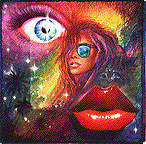Clearly Art was not invented over night. Just imagine
the reaction of the average caveman if one of his number declared one
day that he had created "Art".
"Can you eat it ?"
"No."
"Can you wear it ?"
"No."
"Can you kill something with it ?"
"No."
"Well, what does it do then ?"
"It communicates to others the intensity of my emotions; the
originality of my thoughts and the aesthetic values that may be found
in self expression."
He would have been slung out of the cave faster than you can
say " Saber tooth tiger."
Undoubtedly one of the first abstract concepts must have been the
assertion of the existence of a supreme being. Art evolved from the
creation of religious artifacts and the decoration of every day
items. Over the course of the next several thousand years the artist
successfully made the transition from craftsman to courtier. He
established himself as a respected socialite, pandering to the
glorification of his benefactors, both royal and religious. He
recorded their wealth, their splendor, and illustrated their favorite
classical, or biblical, stories. Works of art became status symbols
which only the rich could afford. It must have seamed to the artist
that he had found the perfect niche. Clearly he was destined to
exploit the vanity of the wealthy and would exist forever in a state
of unassailable good fortune. What could possibly go wrong ?
In 1843 something unimaginable happened. Something as radical and
disruptive to the artist as the invention of the locomotive was to
the stage coach driver. The camera was invented.
The world of science was unfolding and swept aside anything that
stood in its path. The camera sparked off a revolution in art
thinking. It raised questions about the very nature of art and the
value of reproducing every day objects by such old fashioned means.
Incredible advances in mechanization produced inexpensive
DECORATIVE ART and for the first time
the artist was released from his duties as a recorder of events. This
enabled him to focus entirely upon the importance of composition,
color theory, intellectual stimulus and interpretation........... the
principles of fine art.
It was in the light of this dramatic turn of events that the
IMPRESSIONISTS
emerged in the 1870's. Their works were unlike anything that
had gone before and within a few years they changed forever the
general public's concept of the artist. They were frowned upon by
classicists, ridiculed and destined to live their lives as
impoverished intellectuals discussing radical theories that were, to
a large extent, beyond the grasp of the general public. Most of them
lacked private incomes. Since their work was not popular they often
went hungry, or crazy, and occasionally died of anti-social diseases.
They created, in the minds of the public, the image of the artist
that prevails today. Someone who has to suffer, be misunderstood and
die, before his work is accepted. It is extraordinary that their
impact was so intense that they could demolish the artist reputation
that had prevailed for centuries (that of a respected socialite) in a
few decades. By 1884 avant-garde art theory had absorbed them and
moved on to new things but they had given birth to an infant that
would come of age with the turn of the century and came to be known
as Modern Art.
During the 20th Century art evolved, comparatively speaking, as
rapidly as did technology. It's course changed every few years.
However, the concepts became so intellectually involved that they
alienated many members of the public who, not understanding the
images they saw, felt they were being bamboozled. It's not that there
was so much to consider, more a case of poor communication with the
masses, who didn't have access the principles involved. The
intellectualization of art led to its subdivision into
FINE ART ,
DECORATIVE ART ,
GRAPHIC ART ,
etc. and left the man in the street seriously confused.
So it was that art appreciation became an art in its own right,
the subject of numerous University degrees, a visual art which could
not be appreciated on a purely visual level. Today, of course,
society has changed beyond recognition. The average man is far less
average than he used to be. He's more prosperous and intellectually
developed than ever before. For the first time he can afford an
interest in luxuries such as art and, as his awareness of aesthetic
issues grows, the appreciation of fine art is well within his
capabilities. Unfortunately in this age of mass communication it is
much easier to watch adventure stories on the TV. than it is to
expand our intellects. The fine arts will only truly flourish when
they communicate with the average man in a language he understands,
(although there may be something about being misunderstood that
appeals to the average modern artist!)
I hope the information contained within this site will, in some
small way, help the reader see with new eyes.

Island Arts of the
YodaGuy
Antigua, West Indies & Sint Maarten, Netherland Antilles
 THE ART OF
THE ART OF